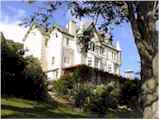

Trengwainton Garden is in a sheltered position in the far west of Cornwall, with distant views over Mounts Bay towards the Lizard. Trengwainton Garden is now in the care of the National Trust. The house is not open to the public. The name Trengwainton is Cornish for 'the settlement of spring' - a reference to the particular beauty of this part of Penwith.
Trengwainton offers a series of Georgian walled gardens, with west facing raised beds (built circa 1820), gives further protection to the most delicate plants and are used to raise early vegetables. A famous collection of tender trees and shrubs is to be found in this virtually frost free garden. It is known that there has been a house here since the 16th century.
Sir Rose Price, 1st Baronet Price, of Trengwainton, was the son of a wealthy Jamaican sugar planter, and it was he who planted the tall beeches and oaks that line the stream and shelter the house. In about 1820 Price created the walled garden at the foot of the drive. He used brick, a warmer but more expensive material than the local granite, to build a series of compartments with raised beds, angled towards the winter sun. Although similar beds were built in other gardens, these at Trengwainton are believed to be the only survivors. These raised beds enabled early crops of vegetables to be produced and tender plants raised.
There is reference to his having constructed a "duck decoy" at Trengwainton in about 1819-20. "Although large numbers of wildfowl at that date frequented the valley, and a good many used to be shot at three different pools, the attempt to decoy them was not successful, and the Decoy was abandoned before Sir Rose Price's death in 1835. This was not a properly constructed Decoy, or else it would have succeeded well, considering the favourable position in which it was placed. It was intended for a trap Decoy, and had no Decoy pipes as usually made. The pond was 6o yards square. At each corner was a small, short pipe leading to a net-covered enclosure of a few feet square. The entrances to the pipes had falling nets to shut the fowl inside the enclosures-should they enter them. In each enclosure was placed a sunken slab of stone on which grain was placed to attract the fowl from out of the pond."
The Bolitho family bought the property in 1867 The Bolithos were cousins of the Williams of Caerhays. However the exotic transfers to the garden only began when Lt. Col. Edward Bolitho inherited the garden in 1925. He was one of the sponsors of Frank Kingdon-Ward's plant-hunting expedition to Assam and the Mishmi Hills in Burma in 1927-8. Hence he obtained a number of specimens which were grown for the first time in the British Isles. Many of the sweet-smelling rhododendrons that flower here in the late spring were raised from seed brought back by that expedition.
The Victorian house faces south-east with views to the sea and St. Michael's Mount. However the garden looks inward, as it needed to be protected from the prevailing westerly winds. Sir Rose Price's original plantations suffered badly in the gales of 1990, and fast re-planting had to be carried out by the National Trust to repair the damage. The garden faces due south and has a wonderfully mild climate, rarely experiencing hard frosts. As a result tender and half-hardy trees, shrubs and other plants have been established here that cannot be grown in the open anywhere else in England.
The "stream and bog" garden follow the stream and you can see feathery bamboos and Australian tree ferns and on its banks, lilies, primulas and other water-loving plants. In late summer hundreds of hydrangeas give the woodland a splash of pale-blue.
Trengwainton Garden, National Trust
The hotel to stay at when visiting Cornwall is Corisande Manor Hotel, Cornwall find out more about it
